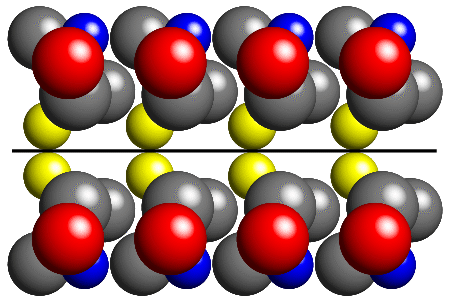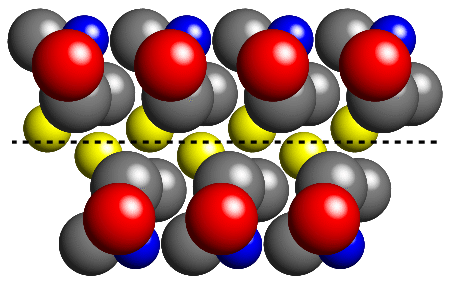 |
Glide Symmetry |
 |
Glide Symmetry |
Glide Symmetry
Concepts
The previous pages on screw axes demonstrated the advantages for molecular
packing of a symmetry operator that is a combination of rotation and
translation compared to that of pure rotation. A similar case can be made
for the mirror planes discussed earlier. The effect of a mirror plane
on the row of molecules used earlier is shown below:


Symbols, Notation, and Operators
A variety of directions are permissible for the translational component of the symmetry operator and so various symbols are required to indicate glide planes. For example, in the above example, a dashed line is used (in contrast to the solid line used for the mirror plane symmetry) to indicate that the translation is along the direction of the line itself. When the translation is perpendicular to the line, a dotted line is used, and so on. A complete list of symbols is provided in the reference page that follows this one.
The labels for this symmetry element depend on the direction (and magnitude) of the translation: the letters a, b, and c are used to indicate that the translational component of the glide plane is 1/2 a, 1/2 b, and 1/2 c, respectively. Note that these labels do not provide any information about the direction of the reflection component of the glide plane. Various other letters, such as n and d are also used for other types of glide plane: these will not be discussed in detail here.
If the glide plane in the above figure has its normal to the screen Y direction and passes through the origin, then the effect of the symmetry element is to reverse the sign of the y coordinate (due to reflection) and to add one-half to the x coordinate (due to translation). The resulting symmetry operator, in this instance, is therefore given by 1/2+x,-y,z; and the symbol for the glide plane is a.
![]() What is the symmetry operator for a b-glide plane passing through
the point (0,0,0) and whose normal is parallel to the X direction?
What is the symmetry operator for a b-glide plane passing through
the point (0,0,0) and whose normal is parallel to the X direction?
| © Copyright 1995-2006. Birkbeck College, University of London. | Author(s): Jeremy Karl Cockcroft |